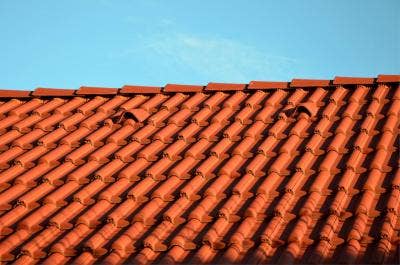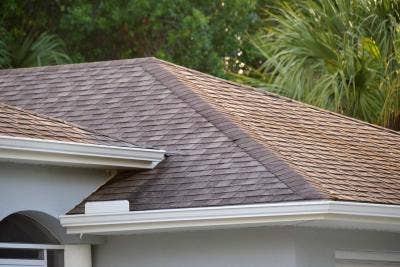Planning to install Clay Roof Tiles?
Clay roof tiles are one of the oldest roofing material known to man. Evidence of the use of clay on the roofs of buildings dates back to 10,000BC and have been found in locations from North American to Rome and Egypt. There have been times when clay was more popular and times when it was less but has always been in use.

A well-maintained clay roof can easily last a lifetime.
Pros and cons
One of the main advantages of clay tiles are their durability. It is common for this type of roofing to last for 100 years so this means there is no need to regularly re-roof, which can be costly and hard work. Another advantage of clay is the astounding variation of tiles that are now available. No matter what colour or finish you are looking for, there will be a clay tile that will fit into the scheme and finish the building perfectly.

Another advantage of clay is that is has reflective properties. This means it helps heating and cooling systems in the house to work at their maximum efficiency without being interfered with by heat from the sun. Clay is immune to mould and rot and is strong enough to withstand a hurricane if installed correctly. Finally, clay does not shrink and expand like materials such as wood over a period of time due to temperature.
The biggest disadvantage of a clay tile is also a sort of advantage €“ its weight. If you are installing clay tiles for the first time, or changing to clay from another material, you need to ensure that the roof supports are strong enough to hold it. Of course, this means that because it is so heavy, it stays in place better than lighter materials. It is also more expensive than some other alternatives but due to the longevity of the material, this will probably even out over time.
Types of clay tiles
As mentioned earlier, there are hundreds of different options in clay roof tiles such as shape, colour and finish. One of the most well-known styles is the plain tile, usually a small rectangular tile around 260mm by 160mm that has been around since the 1400's. plain tiles are laid in an overlapping pattern three tiles deep which results in only the bottom third of each tile being visible. Plain tiles can be found in a few different versions such as handmade tiles that are hand created by a specialist and will be the most expensive version. Others include interlocking plain tiles that are manufactured in a locked pattern that reduces the amount of work needed when on the roof.
The other most commonly found type of clay tile is the pantile. This tile is s-shaped when seen at a cross section and creates the flowing appearance on a roof that is seen across the country. They were brought to the country from the continent back in the 1600s. There are also handmade versions as with the plain tile, interlocking pantiles and double pantiles, a more recent development where the tiles are manufactured in double the size to cut down on work.
Roman tiles are sometimes seen in the UK and these are a little like pantiles. They have a flat shape with a roll running down the tile along the right hand side and come in single and double versions. They went out of fashion in the 1950s but have been revived in recent times, by some manufacturers.
Whatever shape of clay tile you choose upon, there will likely be three grades to select from before you make your final decision. The choice of which to go for is dictated by where you live; the first grade is designed for frost conditions, the second for ice and snow and the third for hot conditions.
Fitting the tiles
Once you have selected the right clay tiles for your roof, fitting them can be relatively straightforward. When fitting them, it is important to use an underlay on the tiles as this can help them deal with the pressures of snow and rain. This is laid on the roof before any of the tiles are put into place.
When fitting tiles, always start from the centre of the space. Each manufacturer will provide instructions for their own products to get the best from them but generally, it will involve layer after layer of tiles overlapping each other. Most tiles have a special edge on them to help create this overlap but make sure, when you are doing this, that there is no dirty of debris on the overlapping spot to ensure a tight finish.
Once you have covered the roof space in the layers of tiles, it is important to finish with the coordinating edging tiles. These stop the roof tiles moving around, prevents any leaks and also gives the roof a finished appearance.
Conclusion
Clay tiles are still one of the most popular roofing materials in the country and due to the long lifespan of them, this is likely to continue. With the range of colours, finishes and designs available, clay tiles will often be the perfect choice for your new roof.
Our Top Videos.


How to install a Velux Integra Electric Roof Window (5 Parts)
In this five-part guide, we take you through the full installation of a Velux GGU Centre Pivot Integra Roof Window onto an...


How to install a Duratech Centre-Pivot Pine Roof Window
Once you begin unpackaging the window, you’ll find in the box the brackets, the handle and the fixings. And there will also be some instructions...
Ideas & Advice
How-tos, tutorials and videos


How and why to use or snap a chalk line
Chalk lines are the fastest way to mark straight guidelines on flat surfaces. They are used extensively in the building and construction industry to speedily and accurately ‘draw’ straight lines between two points. Chalk lines are inexpensive tools...


Skylight Blinds: A Guide To The Different Types
Like many household product, blinds for skylight windows come in all shapes, sizes, and materials. Some are designed with a tangible purpose in mind, while others are more for show. One thing’s for sure - buying any type of skylight blind...








